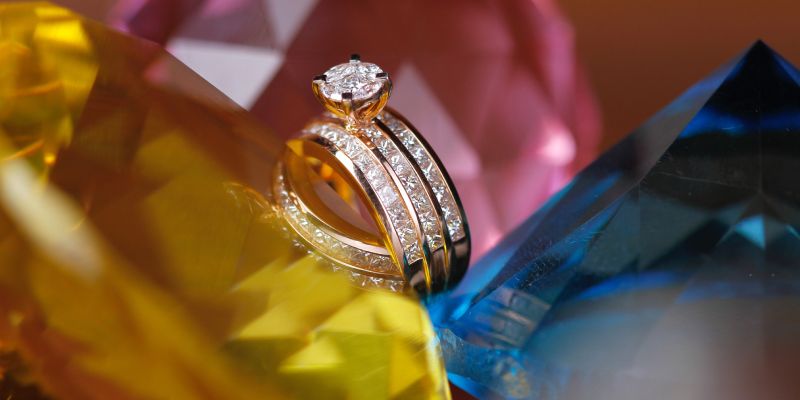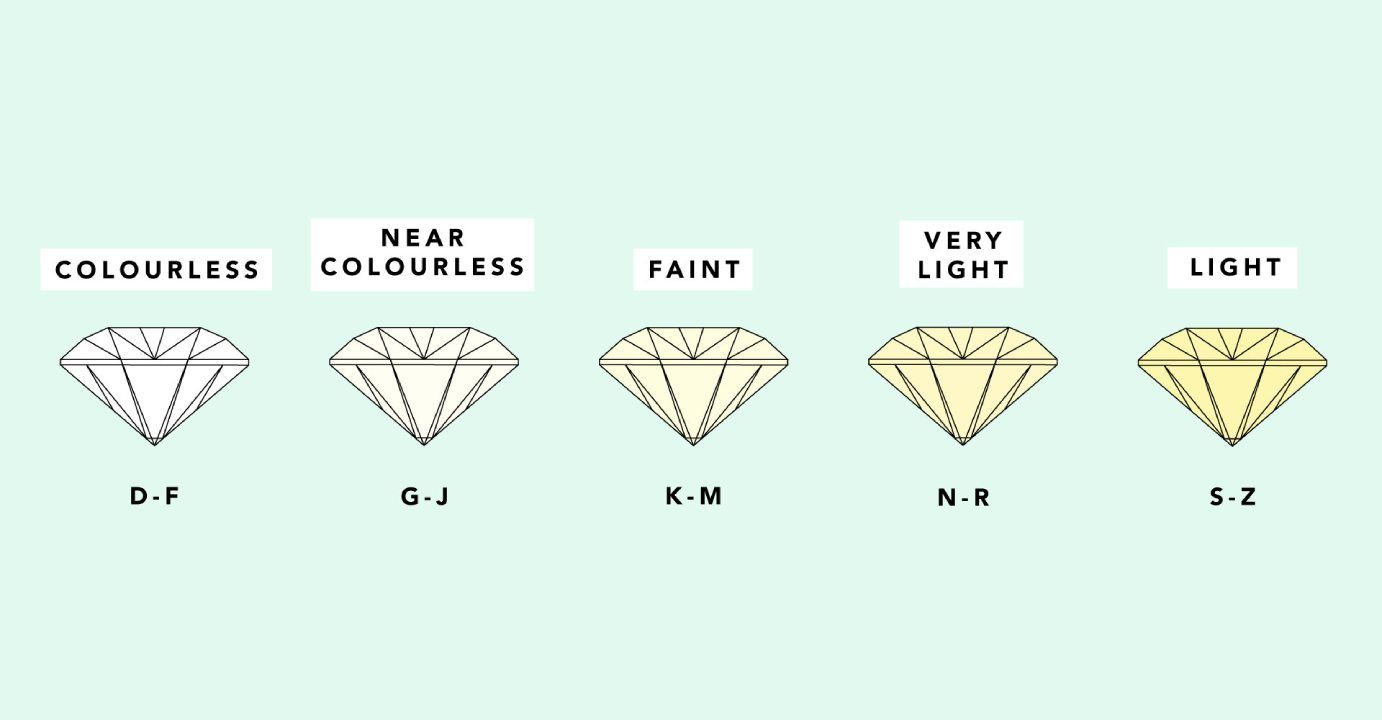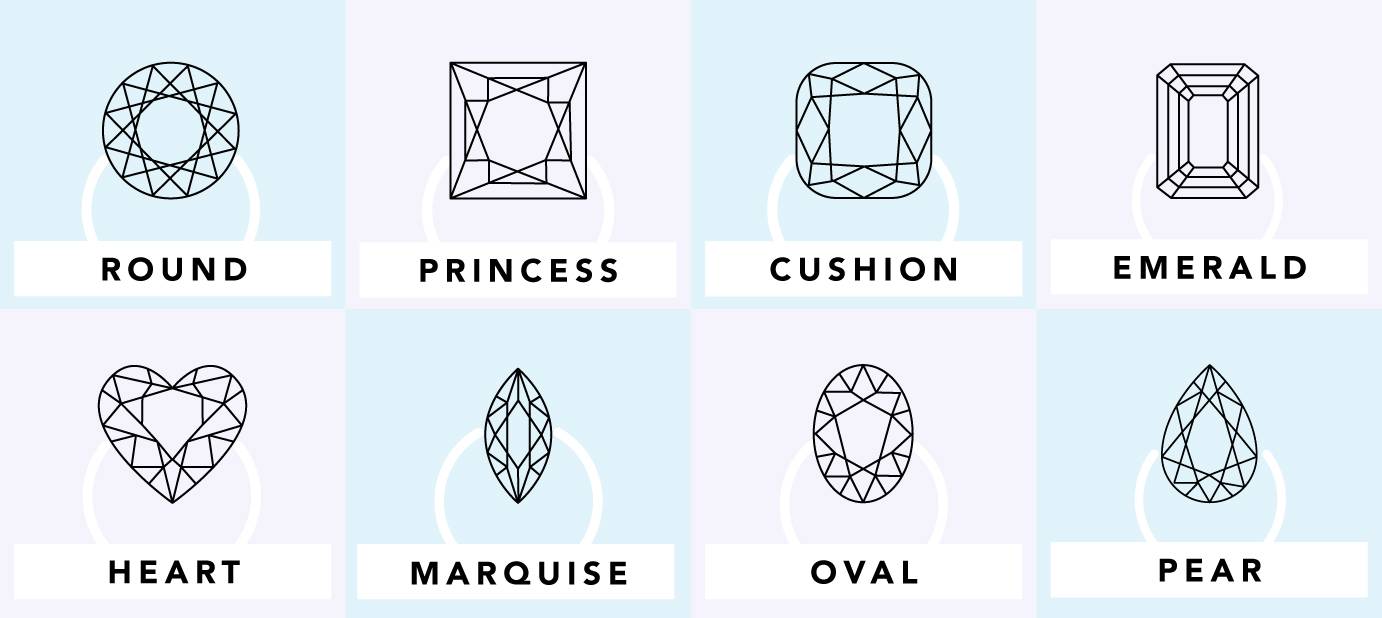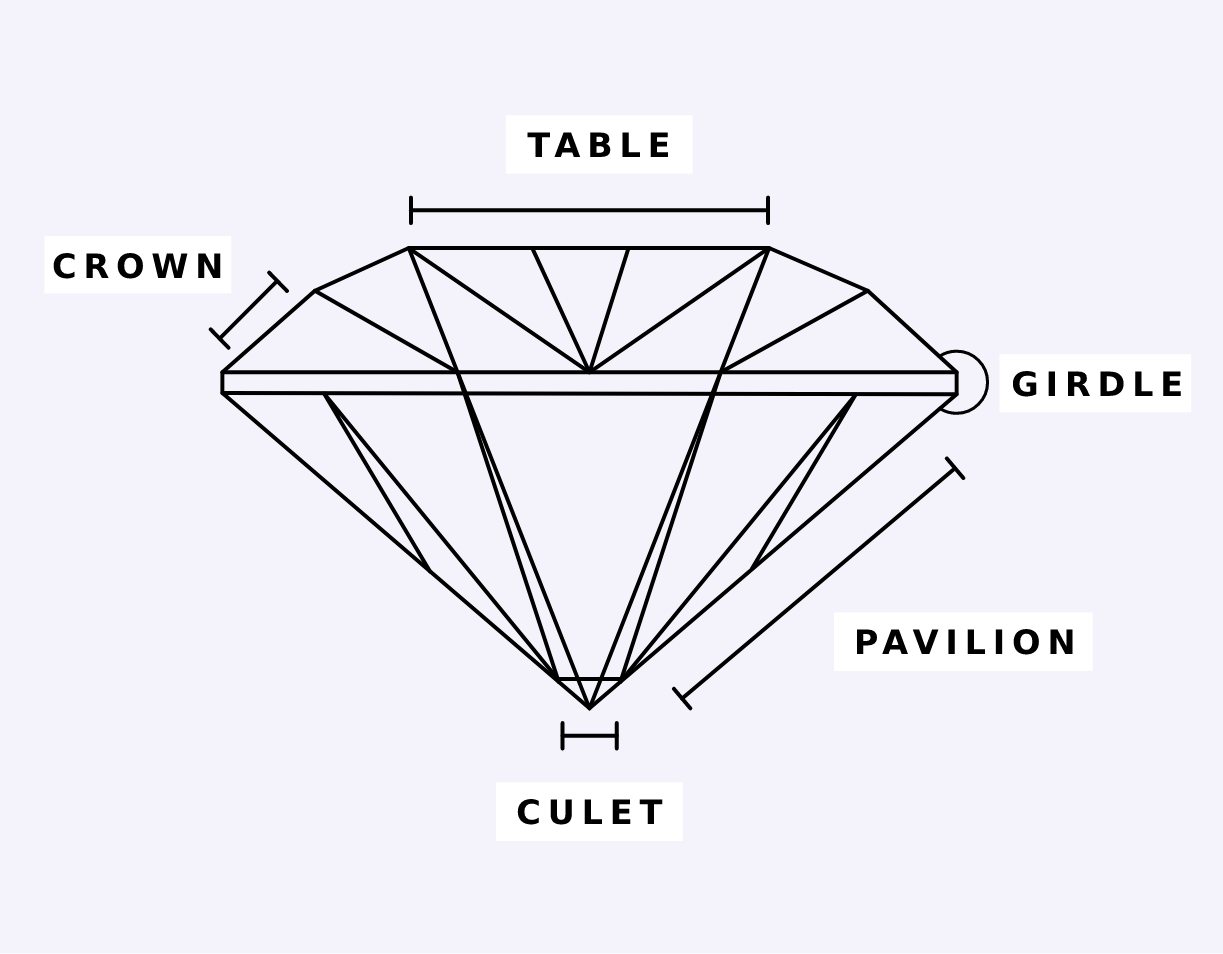Diamond Guide: Understand Cuts, Carats, Clarity & More

Diamonds have long been some of the most sought-after gemstones, celebrated for their style, splendour and status. But if you’re in the market for one of these precious jewels, chances are, you want to do your homework before committing.
From how they're cut and graded to the all-important 4 Cs, key terminology, and what to look for when purchasing, there is much to learn about these majestic, high-status gemstones.
In this guide, our diamond jewellery experts provide all the insights you’ll need to buy diamond jewellery with confidence. Need extra help deciding? Get in touch with our experts today
What is Diamond Grading?
Diamond grading is how the value of a diamond is determined and measured according to the four Cs:
- Cut
- Colour
- Clarity
- Carat
Grading should be performed by a neutral and impartial organisation, such as the International Gemological Institute (IGI) or the Gemological Institute of America (GIA).
At Hatton Jewellers, our diamonds are graded by the World Gemological Institute (WGI). Based in the jewelling district of Hatton Gardens, this globally respected institute gives unbiased gradings to countless jewellers.
What are the Four Cs of Diamonds?
As discussed above, the diamond's four Cs are cut, colour, clarity and carat. But what exactly do these three things mean, and how are they measured?
What is a Diamond Cut?
A diamond cut, in regard to the four Cs, does not refer to the shape but rather how a diamond’s surface interacts with and catches light.
It accounts for the number of symmetrical arrangements of facets (the flat surfaces cut across the surface of the diamond) which alter its shape and appearance, and affect its brilliance - if it’s cut poorly, it won’t be as luminous.
The cut quality of a diamond is measured by:
- Fire (flashes diffused under light)
- Brilliance (brightness)
- Scintillation (sparkle)
- Polish (smoothness of each facet)
- Symmetry (arrangement, size and shape of facets).
Polish and symmetry are two of the most important factors in diamond cuts. Polish refers to the smoothness of the diamond’s facets, and the symmetry covers the alignment of the facets. Diamonds can be dulled if they are poorly polished, and if the surface has been scratched.
What is the Diamond Colour Scale?
The diamond colour scale refers to the absence or presence of colour in your gemstone. The less colour a diamond has, the more value it tends to have, with diamonds with no hue being worth most. However, an exception is if the diamond possesses a very rare colour. For example, red diamonds are extremely valuable, as only thirty are currently known to exist worldwide.
The GIA (Gemological Institute of America) uses a colour grading system of D-Z to measure the degree of colouration, with D being colourless.

Many of the colour differences are subtle and even invisible to an untrained eye. Naturally coloured diamonds that are outside the D-Z colourless and yellow range are called fancy-colour diamonds.
These are rare but come in every colour across the spectrum, with the most popular being blue, green, pink and red. The value of these diamonds generally increases with the intensity of the colour, yet most fancy-coloured diamonds tend to be more muted in colour.
Which Diamond Colour is the Most Expensive?
Red is the rarest colour of diamond and is thus considered to be the most expensive. It is thought that there are less than 30 true red diamonds in the world. The red colour is created during the diamond's formation process, which changes the crystal structure of the diamond and causes light to pass through it.
It is believed that the largest red diamond ever sold weighed over five carats and was bought for $8 million. This would be around $1.6 million per carat.
What is Diamond Clarity?
Clarity is the visual purity of a diamond, meaning how many blemishes (called inclusions) it has. These inclusions may or may not be visible to the naked eye.
What are Diamond Inclusions?
Some types of inclusions that a diamond grader may look for include:
- Bearding (hair-like lines)
- Cavity (a large/deep opening on the surface)
- Chip (a small, shallow opening)
- Cloud (a cluster of pinpoint-like crystals close together- these can affect the light-transmitting properties of the diamond if large in size/density).
What is the Diamond Clarity Scale?
Once inclusions have been located and identified, the diamond will then fall somewhere on the clarity scale:
- FL: Flawless
- IF: Internally Flawless
- VVS diamonds (1 and 2): Very, Very Slightly Included
- VS diamonds (1 and 2): Very Slightly Included
- SI diamonds (1 and 2): Slightly Included
- I diamonds (1, 2 and 3): Imperfect.
An FL-grade diamond is the most flawless and brilliant diamond when it comes to clarity. However, diamonds with a clarity grade of VS2 or higher will not have any visible signs of inclusions or blemishes.
What is Diamond Carat?
Carat refers to the weight of the diamond. An individual carat is defined as 200 milligrams and measured to the 100th decimal place. The easiest way to find out the carat of a diamond is to weigh the stone. Dividing the weight by 0.2 will roughly give you your diamond’s carat.
The carat of your stone can look different in size depending on the shape and cut of the diamond; therefore, carat weight does not necessarily relate to the size of the stone. Our diamond carat size blog can teach you more.
What is the Smallest Carat of Diamond?
Diamonds as small as 0.001 ct can be cut in order to be set around a larger centre stone on an engagement ring. When it comes to earrings, the best size is around 0.25ct to 0.5ct in order to have a versatile earring that can be worn for any occasion.
Should Diamonds be Certified?
Certification and grading of a diamond is essential as it's the only way to know how valuable a jewel truly is and receive assurance that it’s a real diamond. That’s why, at Hatton Jewellers, we secure a WGI certificate for every piece of diamond jewellery we sell.
How Do Diamonds Hold Value?
Diamond rings maintain their value over time as only a finite supply of earth-grown natural diamonds exists.
However, if you’re looking for an investment piece of jewellery, gold (or diamonds set within a gold piece of jewellery) is typically the best option as it’s considered durable and has held its value as a metal for many years. Take a look at our guide to buying jewellery as an investment for further advice.
How to Tell if a Diamond is Real
In addition to acquiring an official certificate from a diamond grader, there are a few other ways to test if a diamond is real. One of the simplest of these is the fog test. Diamonds have high thermal conductivity, meaning that if you breathe on real diamonds, they either won’t fog up or the fog will disperse rapidly. If the fog remains, the stone is likely not a diamond.
Another way to spot a fake diamond is if the stone scratches easily. Diamonds are notoriously difficult to scratch. They are extremely high on the Mohs scale of mineral hardness and can only be scratched by other diamonds. If your jewel is easily scratchable, it’s not a diamond.
Learn more about how to tell if a diamond is real.
What is Diamond Cutting?
Diamond cutting is the process of transforming a raw diamond into the glittering jewel that adorns your ring, bracelet or necklace.
The first step of this process is grading, during which it’s decided how the stone should be cut for the most value. This considers the shape of the rough diamond and the location and number of imperfections. Then the direction of the grain is chosen for the cleavage of the diamond. Given that diamonds have four perfect planes on an atomic level, they can be more easily split across these four axes.
After this, sawing begins. This is traditionally performed with a paper-thin phosphor bronze saw with a diamond dust rim. However, today many diamonds are cut with a laser instead.
The diamond is then girdled, whereby it is rounded into a cone shape. Following this, the diamond is faceted. This is when it is given the specific cut shape that it will be sold as. To finish, it is boiled in hydrochloric and sulphuric acids to remove any surface impurities.
What are the Most Popular Diamond Shapes?
Diamonds are available in several exquisite shapes. Some of the most popular are:
- Round Brilliant Cut: This spectacular diamond cut is called “brilliant” due to its high number of light-reflecting facets.
- Emerald Cut: This elegant cut takes a rectangular shape with cut-off edges, with the linear facets giving striking flashes of light.
- Princess Cut: This inverted pyramid-shaped diamond cut has a stunning square face that brings vibrant fire.
- Oval Cut: This shape adds sleekness to the round brilliant cut by giving it slight elongation.
- Cushion Cut: A softer version of the square cut shape, the cushion cut has gracefully rounded corners.

What is a Step-Cut Diamond?
A step-cut diamond is typically a square or rectangle shape, with the facets in parallel lines on all four sides. Due to their arrangement, the facets on brilliant-cut diamonds are usually smaller than those on step-cut diamonds. The shapes in the step-cut diamond family are Emerald, Asscher and Baguette.
Where Do Hatton Jewellers’ Diamonds Come From?
Hatton Jewellers sources diamonds from around the world, always following the United Nations Kimberley Act, which states that diamonds must be conflict-free. We are also now beginning to source lab-grown diamonds as a lower-cost alternative to mined diamonds.
What Are Lab-Grown Diamonds?
Also known as lab-created and man-made diamonds, lab-grown diamonds have the same properties as natural diamonds. When placed side by side you would not be able to see the difference between them(even under a microscope) - the main, indeed, the only difference is their origin.
Like natural diamonds, lab-grown diamonds have a hardness of 10 on the Mohs scale, meaning they are just as durable as earth-grown diamonds. Depending on the size, lab-grown diamonds can be grown in as little as six to eight weeks and can be up to 40% less expensive than a natural diamond of the same size.
Many still prefer to purchase natural diamonds because of their inherent value and rarity. However, if lab-grown diamonds are an option that interests you, discover our blog on lab-grown diamonds to learn more.
The Anatomy of a Diamond
A diamond is made up of several cuts, each of which affects the amount of light the stone can reflect, consequently impacting its overall sparkle and brilliance.

Diamond Table
The table is the flat surface on the top of a diamond. It is the largest diamond facet and refracts light rays as they hit the diamond, which are then reflected back up. The size of the table impacts how much light can enter the diamond, ultimately impacting the overall sparkle.
Diamond Girdle
The girdle is the widest part of the diamond, where the crown and pavilion join. It is typically hidden when placed in a bezel or halo ring setting, but in a prong or channel setting, the girdle can be seen where no metal touches the diamond.
Diamond Crown
The crown includes everything that sits above the girdle. Like the table, light is passed through the crown and reflected back up, mirroring the light in different directions, resulting in a stunning sparkle.
Diamond Pavillion
The pavilion sits between the crown and cutlet and usually holds the majority of the diamond's weight. The angles and cuts on a diamond pavilion are extremely important in ensuring light is reflected back up through the crown. If the angles are too shallow it can cause the diamond to look dull.
Diamond Cutlet
The cutlet is the very button of the pavilion and is either shaped in a point or a small facet that is parallel to the table. Diamonds with small cutlets are most likely to have the most brilliance as they are able to reflect more light up through the crown and table of the diamond.
How to Keep Diamond Jewellery Clean
Taking your jewellery to a professional cleaner - especially delicate antique jewellery - is always recommended for the best results. However, it is possible to maintain your diamond’s sparkle with home remedies too. Ensure you don’t use harsh materials when cleaning your jewellery though, as this could easily lead to scratching or damaging the item.
Robert Cuomo, Managing Director at Hatton Jewellers, said: “We recommend getting jewellery cleaned at least every six months, either professionally or at home, to keep it looking good as new.
“Regularly check for warning signs of vulnerability in your jewellery, such as loose stones or prongs. This may prevent the need to spend more money to replace lost stones later down the line.”
How to Clean a Diamond
If you’re looking to clean your diamonds at home, follow these simple steps to avoid damage and get your diamond sparkling once again;
- Mix a small bowl of warm water with any mild liquid detergent.
- Brush your jewellery gently with a small, soft brush and be careful not to scratch the metal or diamond.
- Rinse the stone thoroughly under water and pat dry with a soft, lint-free cloth.
- Use a quick dip liquid jewellery cleaner to keep your diamond jewellery shiny.
How to Store Diamond Jewellery
Ensure that when you’re not wearing your diamond, you store it in a clean, dust-free location, such as the box that it came in or a jewellery box with a soft lining. Store it at room temperature and away from direct sunlight too. This will make sure that your jewellery isn’t damaged or lost when not being worn.
How to Style Different Types of Diamond Jewellery
Diamonds add glamour to so many types of jewellery, but there are certain ways you can style them that will show off their sparkle.
How to Wear a Diamond Ring
When looking at how to wear a diamond engagement ring, the traditional option is on the ring finger of your left hand - the clue is in the name! After marriage, your wedding band typically sits beneath your engagement ring so that it is closer to the heart.
Wearing a diamond ring on your hand alone allows the glittering gemstone to enjoy all the attention. However, diamond rings can also be worn alongside other rings to enhance their beauty. The diamond can stand out with plainer bands or create a dazzling array with other coloured gemstone rings.
What are the Different Types of Engagement Rings?
From stones to settings, there is a range of engagement ring types to choose from.
You’ll need to consider your partner's preferences and styles to pick the perfect diamond ring. Diamonds may be the traditional choice for engagement rings but there are also numerous beautiful diamond alternatives for engagement rings, like rubies, sapphires and emeralds.
Take a look at our engagement ring guide to learn more.
How to Wear Diamond Earrings
Diamond earrings are one of the most universal pieces of jewellery and have a timeless quality. A brilliant, round-cut diamond is often considered the most popular, as this cut truly enhances the diamond's sparkle. The typical size for a diamond stud earring is 0.25 carat, and it can be worn no matter what occasion to create an elegant, timeless look.
To make the most out of your diamond earrings, wear your hair in a loose updo to show off their beauty. Although in the past diamonds were often kept for formal and fancy occasions, today they can easily be worn day to day. Diamond studs bring luxury to your look in a classically understated way.
If you’re looking to grab attention, though, try statement diamond earrings. Diamond drop earrings bring elegance and flair to a formal occasion. A diamond stud on one ear and a dangling diamond earring on the other is an asymmetrical style that is bound to draw admiration.
How to Wear a Diamond Necklace
A diamond pendant can be perfectly styled on one of our decadent gold chains. Diamond-encrusted crosses and iced-out pendants create a spectacular look to attract eyes all around. However, diamond necklaces can also offer subtle beauty. A single, brilliant-cut diamond can be striking when paired with a simple chain.
A pendant isn’t needed for a diamond necklace, though - our dazzling diamond chains boast gemstones studded into the links themselves.
How to Wear a Diamond Bracelet
A diamond bracelet is a striking accessory. Wear it with a shorter-sleeved outfit so that the shine of your bracelet can be fully exposed.
Wear the bracelet on your wrist alone to exude classic style, or layer with a gold bracelet or bangle for contrast. A diamond bracelet on each wrist is another excellent option, offering suave symmetry.
How Much Should You Spend on a Diamond?
No two diamonds are exactly the same. Consequently, the costs of diamonds can be completely different. When it comes to the cost of a diamond, a high-quality 1-carat diamond can range anywhere from around £3,000 to £20,000 depending on numerous factors, including whether it is lab-grown.
A diamond's worth can also come down to personal preference. In many cases, the difference between a cheaper diamond and a more expensive one may not even be visible to the untrained eye; the ring’s cut or size may be more important to the wearer. Our blog on the cost of diamonds covers the ins and outs of diamond prices further.
What is the History of Diamonds?
Diamonds have a fascinating history that dates back thousands of years. It is believed that the first ever diamond was discovered in India as far back as 4,000 years ago, with the earliest evidence of trading them stretching back to 800 BCE.
Even then, before technology allowed diamonds to be cut, they were seen as valuable - likely because they were so incredibly resistant. Pliny, a Roman natural philosopher, said in the first century CE that “Diamond is the most valuable, not only of precious stones, but of all things in this world.”
Alexander the Great was the first to bring diamonds to Europe, where they soon became a status symbol. Centuries later, they began being set within jewellery as diamond cutting was mastered. Take a look at our blog for more information on the history of diamonds.
Fun Facts About Diamonds
Diamonds have a rich history and are set within some of the most beautiful pieces of jewellery in the world, but here are also some lesser-known gems of information about diamonds:
- The word ‘Diamond’ comes from the Greek word ‘Adamas’, which means invincible or indestructible.
- Discovered back in 1905 in South Africa, the largest diamond ever discovered weighed a tremendous 3,106 carats.
- Natural diamonds are billions of years old – sometimes over three billion years old!
- The tradition of wearing an engagement ring on the fourth finger of the left hand comes from an ancient Egyptian belief that the vein of love runs directly from the heart to the top of that finger.
To learn more fun facts about diamonds, look at our blog on the 10 secrets you didn’t know about diamonds.
Browse Hatton Jewellers’ range of magnificent diamonds in all shapes and sizes today or explore our blog to learn more about the precious stones and metals we craft with, and the fascinating variety of jewellery types we create.
Have any questions? View our FAQs or contact one of our helpful experts. For more of our articles, check out the Hatton Jewellers blog.

